Secrets of Mental Math, Arthur Benjamin [management books to read .txt] 📗

- Author: Arthur Benjamin
Book online «Secrets of Mental Math, Arthur Benjamin [management books to read .txt] 📗». Author Arthur Benjamin
Next, subtract 560 from 597, which is 37 and reduces your problem to dividing 14 into 37. Since 14 × 2 = 28, your answer is 42. Subtracting 28 from 37 leaves you a remainder of 9. The process of deriving the solution to this problem may be illustrated as follows:

The following problem is slightly harder because the two-digit divisor (here 23) is larger.
682 ÷ 23
In this problem, the answer is a two-digit number because 682 falls between 23 × 10 = 230 and 23 × 100 = 2300. To figure out the tens digit of the two-digit answer, you need to ask how many times 23 goes into 680. If you try 30, you’ll see that it’s slightly too much, as 30 × 23 = 690. Now you know that the answer is 20 something, and you can say so. Then subtract 23 × 20 = 460 from 682 to obtain 222. Since 23 × 9 = 207, the answer is 29 with a remainder of 222 − 207 = 15.

Now consider:
491 ÷ 62
Since 491 is less than 62 × 10 = 620, your answer will simply be a one-digit number with a remainder. You might guess 8, but 62 × 8 = 496, which is a little high. Since 62 × 7 = 434, the answer is 7 with a remainder of 491 − 434 = 57, or


Actually, there’s a nifty trick to make problems like this easier. Remember how you first tried multiplying 62 × 8, but found it came out a little high at 496? Well, that wasn’t a wasted effort. Aside from knowing that the answer is 7, you can also compute the remainder right away. Since 496 is 5 more than 491, the remainder will be 5 less than 62, the divisor. Since 62 − 5 = 57, your answer is 7 . The reason this trick works is because 491 = (62 × 8) − 5 = 62 × (7 + 1) − 5 = (62 × 7 + 62) − 5 = (62 × 7) + (62 − 5) = 62 × 7 + 57.
. The reason this trick works is because 491 = (62 × 8) − 5 = 62 × (7 + 1) − 5 = (62 × 7 + 62) − 5 = (62 × 7) + (62 − 5) = 62 × 7 + 57.
Now try 380 ÷ 39 using the shortcut we just learned. So 39 × 10 = 390, which is too high by 10. Hence the answer is 9 with a remainder of 39 − 10 = 29.
Your next challenge is to divide a two-digit number into a four-digit number:
3657 ÷ 54
Since 54 × 100 = 5400, you know your answer will be a two-digit number. To arrive at the first digit of the answer, you need to figure how many times 54 goes into 3657. Since 54 × 70 = 3780 is a little high, you know the answer must be 60 something.
Next, multiply 54 × 60 = 3240 and subtract 3657 − 3240 = 417. Once you say the 60, your problem has been simplified to 417 ÷ 54. Since 54 × 8 = 432 is a little too high, your last digit is 7 with the remainder 54 − 15 = 39.

Now try your hand at a problem with a three-digit answer:

Simplifying Division Problems
If by this point you’re suffering from brain strain, relax. As promised, I want to share with you a couple of tricks for simplifying certain mental division problems. These tricks are based on the principle of dividing both parts of the problem by a common factor. If both numbers in the problem are even numbers, you can make the problem twice as easy by dividing each number by 2 before you begin. For example, 858 ÷ 16 has two even numbers, and dividing each by 2 yields the much simpler problem of 429 ÷ 8:
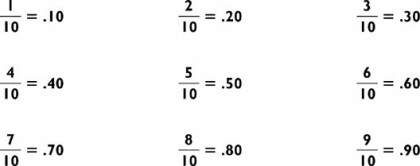
As you can see, the remainders 10 and 5 are not the same; but if you write the remainder in the form of a fraction, you get that  is the same as ⅝. Therefore, when using this method, you must always express the answer in fractional form.
is the same as ⅝. Therefore, when using this method, you must always express the answer in fractional form.
We’ve done both sets of calculations for you to see how much easier it is. Now you try one for practice:

The problem on the right is much easier to calculate mentally. If you’re really alert, you could divide both sides of the original problem by 18 to arrive at an even simpler problem: 201 ÷ 3 = 67.
Watch for problems that can be divided by 2 twice, such as 1652 ÷ 36:

I usually find it easier to divide the problem by 2 twice than to divide both numbers by 4. Next, when both numbers end in 0, you can divide each by 10:

But if both numbers end in 5, double them and then divide both by 10 to simplify the problem. For example:


Finally, if the divisor ends in 5 and the number you’re dividing into ends in 0, multiply both by 2 and then divide by 10, just as you did above:

EXERCISE:TWO-DIGIT DIVISION
Here you’ll find a variety of two-digit division problems that will test your mental prowess, using the simplification techniques explained earlier in this chapter. Check the end of the book for answers and explanations.

MATCHING WITS WITH A CALCULATOR:
LEARNING DECIMALIZATION
As you might guess, I like to work some magic when I convert fractions to decimals. In the case of one-digit fractions, the best way is to commit the following fractions—from halves through elevenths—to memory. This isn’t as hard as it sounds. As you’ll see below, most one-digit fractions have special properties that make them hard to forget. Anytime you can reduce a fraction to one you already know, you’ll speed up the process.
Chances are you already know the decimal equivalent of the following fractions:

Likewise:

The fifths are easy to remember:

The sixths require memorizing only two new answers:

I’ll return to the sevenths in a moment. The eighths are a breeze:


The ninths have a magic all their own:

where the bar indicates that the decimal repeats. For instance, The tenths you already know:

For the elevenths, if you remember that  = .0909, the rest is easy:
= .0909, the rest is easy:


The sevenths are truly remarkable. Once you memorize  , you can get all the other sevenths without having to compute them:
, you can get all the other sevenths without having to compute them:

Note that the same pattern of numbers repeats itself in each fraction. Only the starting point varies. You can figure out the starting point in a flash by multiplying .14 by the numerator. In the case of  , 2 × .14 = .28, so use the sequence that begins with the 2, namely .285714. Likewise with
, 2 × .14 = .28, so use the sequence that begins with the 2, namely .285714. Likewise with  , since 3 × .14 = .42, use the sequence that begins with 4, namely .428571. The rest follow in a similar way.
, since 3 × .14 = .42, use the sequence that begins with 4, namely .428571. The rest follow in a similar way.
You will have to calculate fractions higher than  as you would any other division problem. However, keep your eyes peeled for ways of simplifying such problems. For example, you can simplify the fraction
as you would any other division problem. However, keep your eyes peeled for ways of simplifying such problems. For example, you can simplify the fraction  by dividing both numbers by 2, to reduce it to
by dividing both numbers by 2, to reduce it to  , which is easier to compute.
, which is easier to compute.
If the denominator of the fraction is an even number, you can simplify the fraction by reducing it in half, even if the numerator is odd. For example:

Dividing the numerator and denominator in half reduces it to a sevenths fraction. Although the sevenths sequence previously shown doesn’t provide the decimal for  , once you begin the calculation, the number you memorized will pop up:
, once you begin the calculation, the number you memorized will pop up:
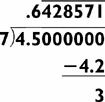
As you can see, you needn’t work out the entire problem. Once you’ve reduced it to dividing 3 by 7, you can make a great impression on an audience by rattling off this long string of numbers almost instantly!
When the divisor ends in 5, it almost always pays to double the problem, then divide by 10. For example,

Numbers that end in 25 or 75 should be multiplied by 4 before dividing by 100.
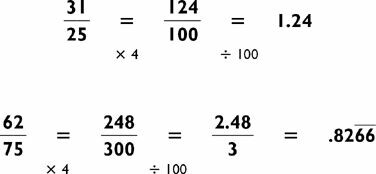
You can even put this trick to use in the middle of a problem. If your fraction is look what happens:

Once the problem is reduced to  , you can further reduce it to
, you can further reduce it to  , which you know to be .875. Thus
, which you know to be .875. Thus  = .1875.
= .1875.

To solve the following problems, don’t forget to employ the various one-digit fractions you already know as decimals. Wherever appropriate, simplify the fraction before converting it to a decimal.

TESTING FOR DIVISIBILITY
In the last section, we saw how division problems could be simplified when both numbers were divisible by a common factor. We end this chapter with a brief discussion of how to determine whether one number is a factor of another number. Being able to find the factors of a number helps us simplify division problems and can speed up many multiplication problems. This will also be a very useful tool when we get to advanced multiplication, as you will often be looking for ways to factor a two-, three-, or even a five-digit number in the middle of a multiplication problem. Being able to factor these numbers quickly is very handy. And besides, I think some of the rules are just beautiful.
It’s easy to test whether a number is divisible by 2. All you need to do is to check if the last digit is even. If the last digit is 2, 4, 6, 8, or 0, the entire number is divisible by 2.
To test whether a number is divisible by 4, check if the two-digit number at the end is divisible by 4. The number 57,852 is a multiple of 4 because 52 = 13 × 4. The number 69,346 is not a multiple of 4 because 46 is not a multiple of 4. The reason this works is because 4 divides evenly into 100 and thus into any multiple of 100. Thus, since 4 divides evenly into 57,800, and 4 divides into 52, we know that 4 divides evenly into their sum, 57,852.
Likewise, since 8 divides into 1000, to test for divisibility by 8, check the last three digits of the number. For the number 14,918, divide 8 into 918. Since this leaves you with a remainder (918 ÷ 8 = 114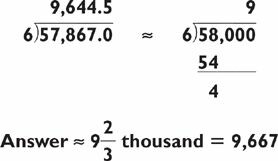 ), the number is not divisible by 8. You could also have observed this by noticing that 18 (the last two digits of 14,918) is not divisible by 4, and since 14,918 is not divisible by 4, it can’t be divisible by 8 either.
), the number is not divisible by 8. You could also have observed this by noticing that 18 (the last two digits of 14,918) is not divisible by 4, and since 14,918 is not divisible by 4, it can’t be divisible by 8 either.
When it comes to divisibility by 3, here’s a cool rule that’s easy to remember: A number is divisible by 3 if and only if the sum of its digits are divisible by 3—no matter how many digits are in the number. To test whether 57,852 is divisible by 3, simply add 5 + 7 + 8 + 5 + 2 = 27. Since 27 is a multiple of 3, we know 57,852 is a multiple of 3. The same amazing rule holds true for divisibility by 9. A number is divisible by 9 if and only if its digits sum to a multiple of 9. Hence, 57,852 is a multiple of 9, whereas 31,416, which sums to 15, is not. The reason this works is based on the fact that the numbers 1, 10, 100, 1,000, 10,000, and so on, are all 1 greater than a multiple of 9.
A number is divisible by 6 if and only if it is even and divisible by 3, so it is easy to test divisibility by 6.
To establish whether a number is divisible by 5 is even easier. Any number, no matter how large, is a multiple of 5 if and only if it ends in 5 or 0.
Establishing divisibility by 11 is almost as easy as determining divisibility by 3 or 9. A number is divisible

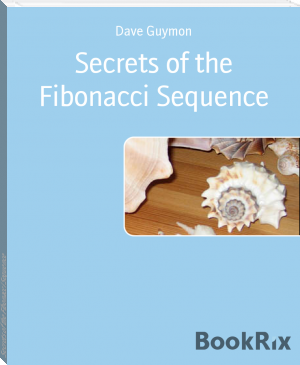


Comments (0)